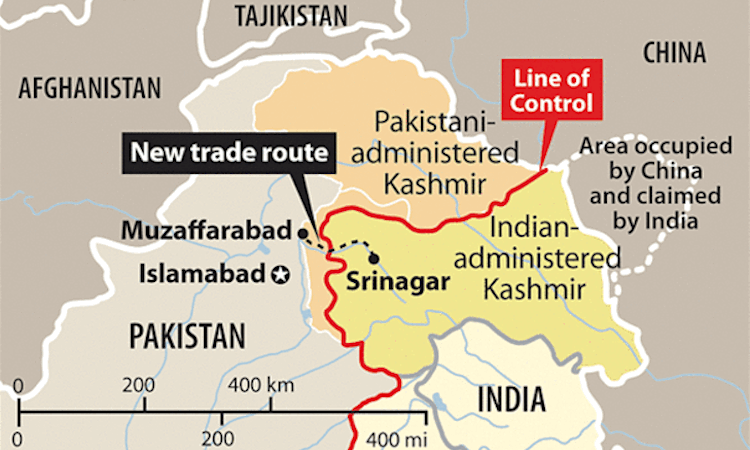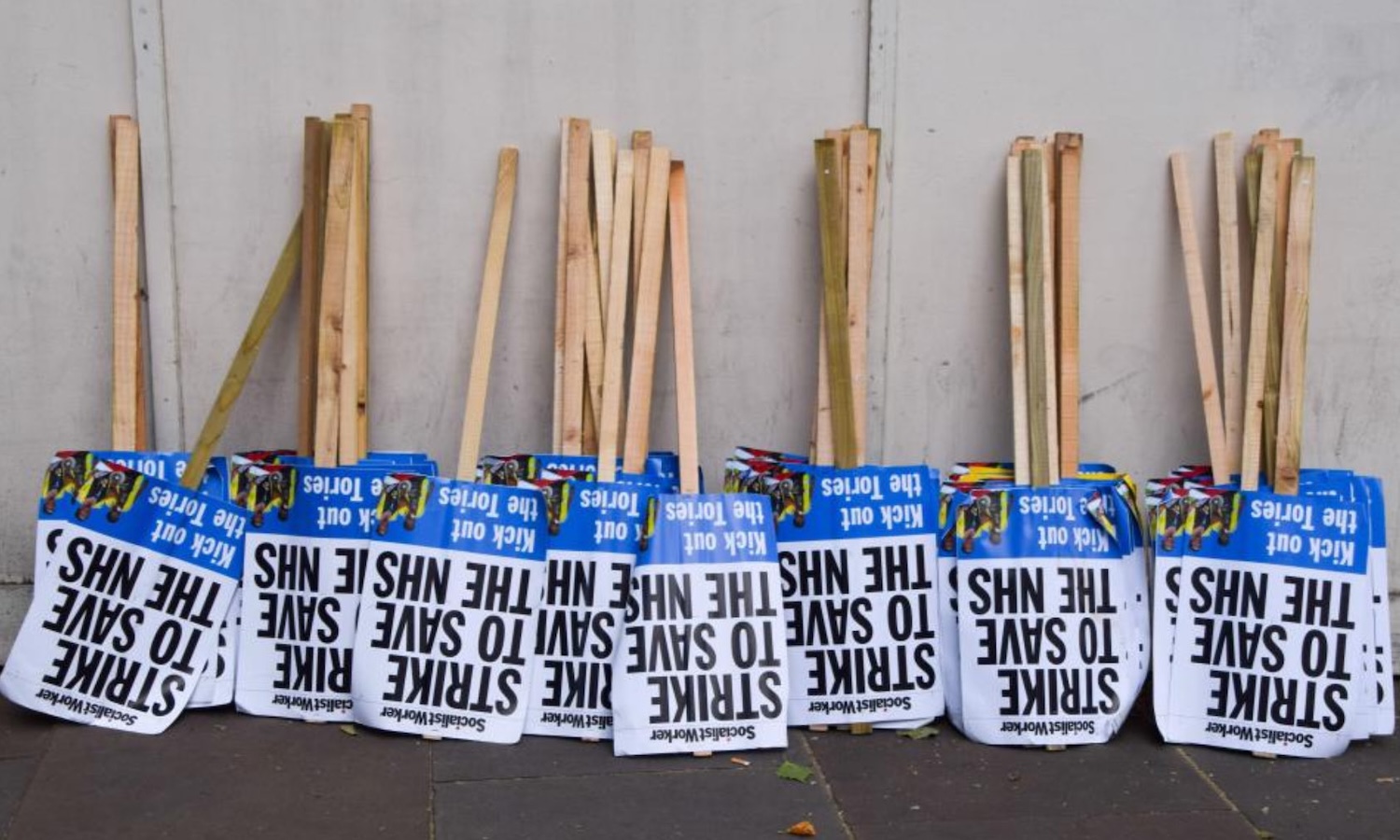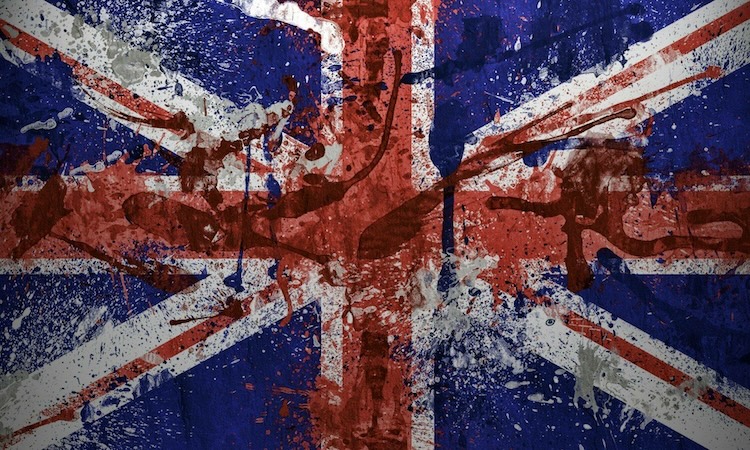The long history of hostilities between India and Pakistan in the disputed region of Kashmir was extended recently via a series of armed clashes carried out between 22 April and 10 May 2025. The latest flare-up occurred when the group known as the ‘Resistance Front’, an offshoot of Pakistan-based Lashkar-e-Taiba, carried out a massacre of hindu tourists in Pahalgam, Indian-controlled Kashmir.
The Indian government, headed by Narendra Modi of the BJP, immediately accused the Pakistani government of complicity and took a series of actions that led to exchanges of artillery fire and air battles between the Pakistani and Indian air forces.
Disputed Kashmir
The disputed status of Kashmir stems from its incorporation into India as part of Britain’s partition of the subcontinent in 1947, but the origins of the conflict arose earlier during the rule of the British East India Company. The princely state of Jammu and Kashmir was formed after East India company forces defeated the Punjabi sikh empire and forced it to cede the Kashmir valley to the British under the terms of the Treaty of Amritsar of 1846.
The territory was then sold to Gulab Singh, a former nobleman in the court of sikh maharaja (king) Ranjit Singh. Gulab Singh, a Hindu of the Rajput Dogra clan, having sided with the British during the war, went on to found the Dogra dynasty that ruled over Kashmir as a protectorate within British occupied India until independence in 1947.
As was always the case with the princely states of British India, the great majority of the peasants who made up the population of Kashmir were muslim while the puppet princes who ruled it were hindu. This is part of what created the dispute after Indian independence and the partition of the country. The plan to use religious criteria to split what had been British-occupied India into two states, India and Pakistan, was one that the imperialists were extremely keen on.
The British were finally forced out of India following multiple revolts of the masses that spread to the Indian army, which the Raj had relied upon for controlling the vast territory of the subcontinent. When confronted with the fact that they could no longer rely upon Indian troops to follow orders, the imperialists prepared to leave – but not before they had created as many problems as possible in order to disrupt the future development of the country.
Capitalising upon divisions they had fostered between hindus and muslims (among others), the British jumped at the chance of partitioning the country into majority hindu and majority muslim areas.
The last maharaja of Kashmir, Hari Singh, opted to join India in 1947, but this was immediately countered by the first government of the newly-created state of Pakistan, which sent irregular forces in to try and seize the state. The 1947 war ended in a stalemate, but left the Indian government in control of the bulk of the territory.
Further wars over Kashmir were fought between India and Pakistan in 1965 and 1999, which saw minimal changes in the land held by either side. The fact that, almost 80 years after independence, the border dispute still has capability of provoking a war tells us that the departing colonisers’ tactic of splitting the country into two hostile camps is still paying dividends for imperialism.
The purpose of partition, from the British point of view, was to create exactly the kind of long-running dispute that has emerged – to destabilise both countries, distract their populations, divert their resources, and fuel religious sectarianism into the bargain. The imperialists know very well that states which are locked into a war mentality based on religious sectarian strife are unable to develop to their full potential. That is why, when forced to concede independence, they work to make sure that any independent state has as many religious, ethnic and territorial disputes to contend with as possible.
It is notable that although Lord Louis Mountbatten was the Raj’s royal representative sent to oversee independence and partition, it was the allegedly ‘socialist’ and NHS-creating ‘Labour’ government of Clement Attlee that was in government in Britain at the time of the great division in 1947 – a division that resulted not only in lasting destabilisation but in contemporaneous pogroms causing millions of deaths.
This human death toll is almost never discussed in British media or British schools, and when it is, it is presented as something homegrown – some innate inability of backward Indians to get along in a civilised way.
To the great detriment of the Indian people, this British-created sectarian policy of divide and rule has been seized upon and perpetuated by the ruling classes of both India and Pakistan (of all political stripes, including Congress and the BJP in India) as they continue ruthlessly to exploit the Indian and Pakistani working class and peasantry.
The latest clash
Following the attack on tourists in Pahalgam, Delhi was quick to point the finger of blame at Islamabad. Successive Indian governments have made similar accusations that the Pakistani government is sponsoring irregular forces such as the ‘Resistance Front’ and Lashkar-e-Taiba, which have been carrying out attacks on security forces and civilians in Kashmir – and more widely across India – since at least the 1980s.
The precise extent of Pakistani government involvement in these attacks cannot be verified, but it is widely acknowledged that the notorious Pakistani Inter-Services-Intelligence (ISI) has been using islamic fundamentalist groups to wage proxy wars since the 1980s. This began with the war in Afghanistan against the progressive Afghan government headed by Mohammad Najibullah, who had the support of the Soviet army to safeguard his administration.
The ISI was used by US imperialism as a tool for managing the various reactionary islamic groups that were deployed to Afghanistan to try to bring down the then pro-Soviet government and subsequently to fight the USSR directly. So although the exact extent of the involvement of the ISI in the Pahalgam massacre is unclear, Pakistan’s usage of reactionary islamic armed groups is well established.
As news of the massacre broke, the Modi government promptly used it as a pretext to cancel the 1960 Indus Water treaty – a move that Modi has apparently long been considering.
The Indian government then launched ‘Operation Sindoor’ on 7 May, targeting nine sites associated with the militant groups Jaish-e-Mohammed and Lashkar-e-Taiba in Pakistan and Pakistan-administered Kashmir. The BJP government claimed that the strikes, involving missile attacks and Indian-Israeli developed SkyStriker loitering munitions (drones), “killed over 100 militants” without targeting Pakistani military or civilian sites.
The Pakistani government countered by claiming that the strikes had caused 31 civilian deaths, including a child, alleging that India had hit civilian areas.
From there, the conflict began to escalate rapidly. On 7-8 May, Pakistan launched a mortar attack on Poonch, Jammu, killing one Indian soldier and 16 civilians, destroying homes, schools and a sikh temple. Pakistan claimed that India had struck three of its airbases, including the Noor airbase near Islamabad, prompting retaliatory strikes by Pakistan as part of ‘Operation Bunyanun Marsoos’, which targeted Indian airbases and a BrahMos missile storage site. India reported intercepting Pakistani drones and jets, with unconfirmed losses, including possibly a Rafale jet. Pakistan claimed to have shot down 77 Indian drones, while India reported neutralising Pakistani air defences, including a radar site.
As the dust settled on these encounters, it appeared that the biggest winner in military terms had in fact been China. This was because Chinese J-10CE fifth-generation fighters, operated by the Pakistani air force, shot down India’s French-supplied Rafale jets, though the number of Indian losses in the air battle is still contested.
War in a multipolar world
A notable aspect of the Indo-Pakistan conflict is how the various allies of the two warring parties came into play.
The Pakistani state has long been seen (correctly) as a willing tool of imperialism, with its politically dominant military hierarchy being closely aligned with imperialism (first British now US). Pakistan’s military hierarchy has shown itself willing to carry out coups against any leader who has tried to plot a more independent path for Pakistan, from Zulfikar Ali Bhutto to Imran Khan. Consequently Pakistan has cleaved to the US imperialist bloc.
This alignment with the USA has led to revulsion on the part of the Pakistani masses, however, who flocked to support Imran Khan when he was ousted as prime minister and imprisoned after losing the support of the Pakistani army because he had tried to subject it to a small degree of civilian control.
The other tendency operating within the Pakistani state since 1959 has been an increasingly important economic and military alliance with China. This dates back to the Sino-Soviet split, when Soviet Russia had close ties to India.
As a result of its connection with China, Pakistan has become part of the Belt and Road Initiative, and the trade between the two countries has become increasingly important in recent years. This has coincided with an upturn in Balochi separatist activity in Pakistan, as well as repeated attacks on Chinese engineers working on BRI infrastructure projects in Pakistan.
India is a founder member of Brics but is also subject to great pressure from the US imperialists to move to a more aggressively anti-China stance in the hope that this will disrupt the further development of Brics and stymie India’s path toward greater independence. The Indian bourgeoisie continues to balance between Russia on one side and the USA on other. It profits greatly from reselling Russian oil, but has also joined the ‘Quad’, an anti-China military alliance consisting of the USA, Australia, Japan and India.
The international reaction to clashes between India and Pakistan has reflected this fragmented picture of international political alliances. What is certain is that the imperialists have a shared interest in continued conflict between India and Pakistan, which increases tensions inside the developing Brics system.
Kashmiris’ voice not heard
After the first war over Kashmir in 1947, the United Nations decreed that the state’s future should be decided by Kashmiris in a referendum. Almost 80 years later, this has still not taken place.
The special autonomous status promised by the Indian government for Kashmir, in return for Maharaja Hari Singh bringing the state into India, began to be eroded after 1953. This erosion fuelled hostility towards India, which in turn was met by further erosion and even greater hostility until all autonomy was finally removed by the Modi government in 2019.
Neither of the ruling classes concerned have any interest in allowing the self-determination of Kashmiris, and both continue to claim to speak for the masses there. Indian armed forces have been accused of committing a variety of abuses against the Kashmiri population while the militias backed by the Pakistani army have also been accused of horrific acts such as mass rapes.
The way forward
Many believe that the crisis would be solved were the people of Kashmir free to exercise self-determination, most likely leading to the establishment of an independent state over the entire historic territory of Kashmir. But neither the Indian nor the Pakistani bourgeoisie are prepared to take the risk of losing out in any such process.
Moreover, for a small state such as Kashmir, with a population of around 17 million, (12.5 million of whom currently are Indian, with 4.5 million in Pakistan) to exercise true independence would be an impossibility in today’s political landscape. More likely than not it would end up being used as another occupation fortress for US armed forces – all the better to interfere in the affairs of India, Pakistan, Nepal, Afghanistan and central Asia – and, of course, Russia and China.
This points to a much wider problem: namely, the contradictions and antagonisms that have plagued India and Pakistan since independence in August 1947.
India is now one of the largest economies in the world, yet 60 percent of its population of 1.3 billion people live on $3.10 a day or less (the figure used by the World Bank to measure the prevalence of moderate poverty in developing countries). The contrast between the growing wealth of the Indian bourgeois and the continued impoverishment of the vast proletarian and peasant masses is one that neither the BJP nor the Congress party has shown any ability or will to resolve. Both parties, like all the rest of the Indian bourgeois organisations, are committed to free-market economics and are firmly the vehicles of the wealthy ruling bourgeois and landed classes.
In Pakistan the situation is similar, with 42.5 percent of the population living below the poverty line according to the World Bank. Pakistan is also paying the price for its ruling military clique’s long-term collaboration with imperialism, with even defence minister Khawaja Asif commenting recently that being allied with the USA had done great damage to the country.
The Kashmiri crisis provides deeply cynical bourgeois politicians in both countries with a means of drumming up nationalistic and communal hatreds to distract from growing domestic problems. This might be why Modi has been declaring that the war has not yet ended, despite the truce that was declared on 10 May.
For Pakistan, only by ending collaboration with Anglo-American imperialism can the country truly achieve independence and sovereignty. For India, the attempt at attempting to align both with Brics and with US imperialism presents no positive way forward in the medium to long term. US imperialism does not look at India as a ‘partner’ because the imperialists have no ‘partners’ but only subservient stooges who do the USA’s bidding.
Continued animosity between these two great states over Kashmir is a legacy of the wretched ‘gifts’ of the British empire (just as were the Indo-Chinese war of 1962, the war between East and West Pakistan in 1971, and the long-lasting Sri Lankan conflict between the Tamil and Sinhalese populations of that island) – a poisoned legacy that has been further compounded by the policies of the Indian and Pakistani bourgeoisies since 1947.
It is vital that this wound be healed, and the only way this can be done in the short term is for the Indian government to cease stoking confessional violence and to honour the commitment made when Kashmir first acceded to India: anti-muslim pogroms much stop and Kashmir’s special status within India must be comprehensively re-established. This will not stop Pakistan claiming territorial rights over the muslim-majority area, of course – but it is clear that the main basis for sympathy with this claim amongst the population of Indian-administered Kashmir lies in the mistreatment of muslims – both in the disputed territory and across India.
Given the damage that their mutual enmity is causing to both countries, their best way forward would be to negotiate a treaty of friendship and cooperation in the light of their joint membership of Brics. While there are strong forces hostile to such a move, there are also forces who would very much favour it, and those forces have the real interests of the masses of the subcontinent on their side.
As we have argued throughout this article, the status of Kashmir is but one aspect of a much broader problem, which is the lingering effects of partition and the almost eighty-year state of war and near-war that has existed between India and Pakistan – as well as the ongoing cancer of communalism that is persistently and periodically reignited by bourgeois demagogues in both countries.
The chief beneficiaries of this division are the imperialists and the most reactionary ruling-class elements on both sides of the Indo-Pak border. Ending the ongoing dispute over Kashmir would remove one barrier to cooperation between Delhi and Islamabad – cooperation that could lead to further mutual economic development and help to strengthen the progressive social forces in both countries and across the developing world.
Ultimately, of course, the enormous human, cultural and economic potential of India and Pakistan will only be realised through the removal of their reactionary bourgeois ruling classes and the building of socialism across the Indian subcontinent. Only through the coming to power of the proletariat and peasantry can the damage done by imperialism be fully undone and the gigantic potential of the subcontinent, with its multitude of natural resources and its talented and creative peoples, break free of the bonds of reaction.
















